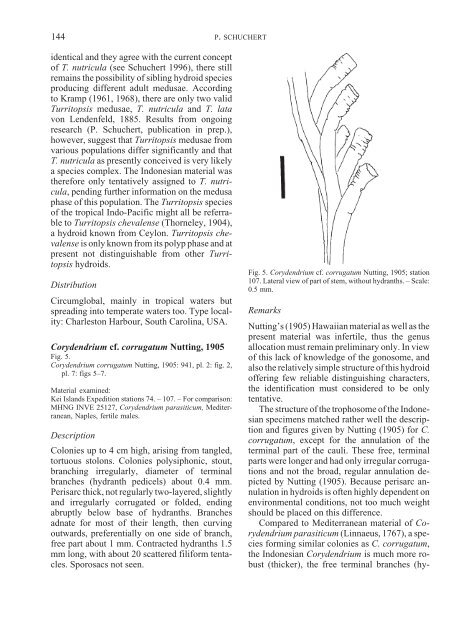Hydroids (Cnidaria, Hydrozoa) of the Danish expedition to
Hydroids (Cnidaria, Hydrozoa) of the Danish expedition to
Hydroids (Cnidaria, Hydrozoa) of the Danish expedition to
Create successful ePaper yourself
Turn your PDF publications into a flip-book with our unique Google optimized e-Paper software.
144<br />
identical and <strong>the</strong>y agree with <strong>the</strong> current concept<br />
<strong>of</strong> T. nutricula (see Schuchert 1996), <strong>the</strong>re still<br />
remains <strong>the</strong> possibility <strong>of</strong> sibling hydroid species<br />
producing different adult medusae. According<br />
<strong>to</strong> Kramp (1961, 1968), <strong>the</strong>re are only two valid<br />
Turri<strong>to</strong>psis medusae, T. nutricula and T. lata<br />
von Lendenfeld, 1885. Results from ongoing<br />
research (P. Schuchert, publication in prep.),<br />
however, suggest that Turri<strong>to</strong>psis medusae from<br />
various populations differ significantly and that<br />
T. nutricula as presently conceived is very likely<br />
a species complex. The Indonesian material was<br />
<strong>the</strong>refore only tentatively assigned <strong>to</strong> T. nutricula,<br />
pending fur<strong>the</strong>r information on <strong>the</strong> medusa<br />
phase <strong>of</strong> this population. The Turri<strong>to</strong>psis species<br />
<strong>of</strong> <strong>the</strong> tropical Indo-Pacific might all be referrable<br />
<strong>to</strong> Turri<strong>to</strong>psis chevalense (Thorneley, 1904),<br />
a hydroid known from Ceylon. Turri<strong>to</strong>psis chevalense<br />
is only known from its polyp phase and at<br />
present not distinguishable from o<strong>the</strong>r Turri<strong>to</strong>psis<br />
hydroids.<br />
Distribution<br />
Circumglobal, mainly in tropical waters but<br />
spreading in<strong>to</strong> temperate waters <strong>to</strong>o. Type locality:<br />
Charles<strong>to</strong>n Harbour, South Carolina, USA.<br />
Corydendrium cf. corrugatum Nutting, 1905<br />
Fig. 5.<br />
Corydendrium corrugatum Nutting, 1905: 941, pl. 2: fig. 2,<br />
pl. 7: figs 5–7.<br />
Material examined:<br />
Kei Islands Expedition stations 74. – 107. – For comparison:<br />
MHNG INVE 25127, Corydendrium parasiticum, Mediterranean,<br />
Naples, fertile males.<br />
Description<br />
Colonies up <strong>to</strong> 4 cm high, arising from tangled,<br />
<strong>to</strong>rtuous s<strong>to</strong>lons. Colonies polysiphonic, s<strong>to</strong>ut,<br />
branching irregularly, diameter <strong>of</strong> terminal<br />
branches (hydranth pedicels) about 0.4 mm.<br />
Perisarc thick, not regularly two-layered, slightly<br />
and irregularly corrugated or folded, ending<br />
abruptly below base <strong>of</strong> hydranths. Branches<br />
adnate for most <strong>of</strong> <strong>the</strong>ir length, <strong>the</strong>n curving<br />
outwards, preferentially on one side <strong>of</strong> branch,<br />
free part about 1 mm. Contracted hydranths 1.5<br />
mm long, with about 20 scattered filiform tentacles.<br />
Sporosacs not seen.<br />
P. SCHUCHERT<br />
Fig. 5. Corydendrium cf. corrugatum Nutting, 1905; station<br />
107. Lateral view <strong>of</strong> part <strong>of</strong> stem, without hydranths. – Scale:<br />
0.5 mm.<br />
Remarks<br />
Nutting’s (1905) Hawaiian material as well as <strong>the</strong><br />
present material was infertile, thus <strong>the</strong> genus<br />
allocation must remain preliminary only. In view<br />
<strong>of</strong> this lack <strong>of</strong> knowledge <strong>of</strong> <strong>the</strong> gonosome, and<br />
also <strong>the</strong> relatively simple structure <strong>of</strong> this hydroid<br />
<strong>of</strong>fering few reliable distinguishing characters,<br />
<strong>the</strong> identification must considered <strong>to</strong> be only<br />
tentative.<br />
The structure <strong>of</strong> <strong>the</strong> trophosome <strong>of</strong> <strong>the</strong> Indonesian<br />
specimens matched ra<strong>the</strong>r well <strong>the</strong> description<br />
and figures given by Nutting (1905) for C.<br />
corrugatum, except for <strong>the</strong> annulation <strong>of</strong> <strong>the</strong><br />
terminal part <strong>of</strong> <strong>the</strong> cauli. These free, terminal<br />
parts were longer and had only irregular corrugations<br />
and not <strong>the</strong> broad, regular annulation depicted<br />
by Nutting (1905). Because perisarc annulation<br />
in hydroids is <strong>of</strong>ten highly dependent on<br />
environmental conditions, not <strong>to</strong>o much weight<br />
should be placed on this difference.<br />
Compared <strong>to</strong> Mediterranean material <strong>of</strong> Corydendrium<br />
parasiticum (Linnaeus, 1767), a species<br />
forming similar colonies as C. corrugatum,<br />
<strong>the</strong> Indonesian Corydendrium is much more robust<br />
(thicker), <strong>the</strong> free terminal branches (hy-

















